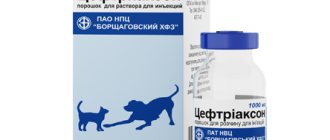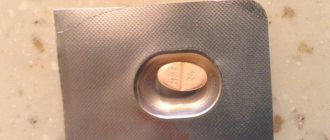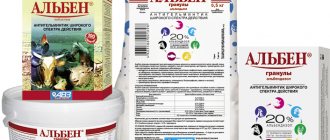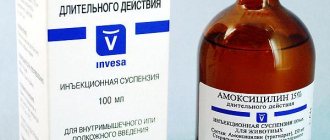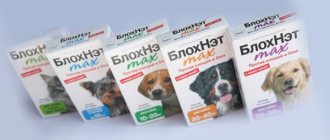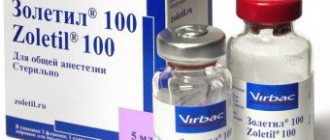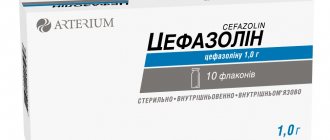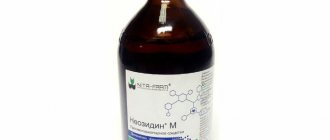How to use and apply
Depending on the form of the drug, the medicine must be used differently. Now we will tell you in more detail how to use Ciprovet.
Eye drops
- Before instilling the medicine, you need to treat your pet's eyes with an antiseptic eye spray. You should also wipe your eyes from various accumulations in the corners of the eyes. The most convenient way to do this is with cotton pads.
- Then place one drop of Ciprovet in each eye. This procedure should be repeated for 1-2 weeks, depending on the specific disease. Drops should be instilled 3 times a day.
Drops
Tablets instructions
- You can forcefully give the whole tablet; to do this, it should be placed on the root of the tongue. The pet's swallowing reflex will work, so it will quickly swallow it.
- Using a syringe without a needle, pour a small amount of warm water into the mouth, in this case the tablet will not stick to the walls of the esophagus.
- You can also grind the tablet into powder and then add it to your pet's food. Add to a single serving so that your pet eats the tablet in one meal.
Composition and release forms
Tsiprovet is a complex antibacterial veterinary drug belonging to the group of fluoroquinolones. Note that fluoroquinolones have no natural analogues. Available in the form of yellow-coated tablets. The medicine, intended for oral administration, is packaged in ten tablets, which are packed in metal blisters.
recommended articles:
- Why does a cat squint one eye?
- Changes in eye color in cats
In traditional veterinary practice, Tsiprovet is used in the treatment of acute and chronic bacterial infections of the gastrointestinal tract, respiratory tract, genitourinary tract, and biliary tract in cats of various breeds and age groups.
Important! Ciprovet is also available in the form of ophthalmic drops in glass bottles for the treatment of conjunctivitis, keratitis, eye diseases of various etiologies and pathogenesis.
The main active component of the pharmacological agent is ciprofloxacin hydrochloride. Each tablet contains 15 mg of the substance. The pills also contain excipients: lactulose, starch, calcium stearate, which enhance the effect of the main components.
Ciprovet tablets for cats
When are tablets, drops and solution prescribed?
Tablets are prescribed for the following diseases:
- Bacterial lesions of the mucous membranes.
- Infectious pathologies of the musculoskeletal system.
- Infections of the genitourinary system and gall bladder.
- Damages of the respiratory system that are caused by bacteria or infections.
- Infectious pathologies of the digestive system.
Drops are prescribed for eye injuries:
- Blepharitis.
- Conjunctivitis.
- Keratitis.
- Corneal ulcer.
Conjunctevitis
Injections are used in the following cases:
- Atrophic rhinitis.
- Umbilical infection.
- Infectious skin diseases.
- Joint diseases caused by infections.
- Bronchopneumonia.
- Salmonellosis.
- Colibacillosis.
Skin disease
Pharmacological properties and indications for use
The drug belongs to the group of antibacterial drugs from the fluoroquinolones series. The medicine provides anti-inflammatory, antiseptic and antibacterial effects. Sensitive to the action of the active substance:
- mycobacteria;
- staphylococci;
- simple mushrooms;
- streptococci;
- coli;
- chlamydia;
- salmonella;
- toxoplasma.
The effectiveness of the drug is due to the ability to influence the DNA of a pathogenic microorganism. Absorption of the drug occurs from the digestive tract or through the mucous membrane of the eye. The drug is found in tissues and internal organs. Excretion from the animal's body is carried out with urine and feces. The active substance can penetrate into the milk of cats during lactation.
The indication for prescribing the drug is an infectious pathology occurring in acute or chronic form. It is possible to use the drug for the treatment of systemic pathology during an exacerbation. The drug in tablet form is effective for the following conditions:
- damage to the gastrointestinal tract by bacterial infection;
- respiratory diseases;
- inflammation of cartilage, joints, skin;
- infectious lesions of the biliary tract and genitourinary system.
Eye drops are prescribed for the treatment of:
- conjunctivitis;
- eye injuries;
- blepharospasm;
- uveitis;
- bruise;
- keratitis.
The drug can also be used to reduce the risk of secondary infection or to prevent exacerbation of the disease after completion of the treatment course.
What's included
Pills
- Ciprofloxacin.
Drops
- Benzalkonium chloride.
- Water for injections.
- Trilon B.
- Ciprofloxacin.
Injection
- Ciprofloxacin.
- Trilon B.
- Succinic acid.
- Water for injections.
Intramuscular injection
Interaction with other drugs
Ciprovet cannot be combined with the following antibiotics:
- chloramphenicol;
- tetracyclines;
- macrolides;
- theophylline;
- non-steroidal anti-inflammatory drugs;
- medications containing magnesium, calcium or aluminum cations.
Ciprovet should not be used in conjunction with bacteriostatic antibiotics.
Ciprovet drops cannot be combined with solutions with a pH level of 3–4, which are chemically or physically unstable. If, in addition to Ciprovet, other eye medications are prescribed, then they should be used at intervals of at least 5 minutes.
Tsiprovet can be combined with antiviral agents, immunomodulators and symptomatic medications:
- Suprastin;
- Kotervin;
- Gamavit;
- Milbemax;
- Fortiflora.
Photo gallery: drugs with which Ciprovet can be combined
Allergy medications (for example, Suprastin) can be used together with antibiotics. If we are talking about diseases of the genitourinary system, then Tsiprovet can be used together with diuretics, for example, Kotervin
Antibiotics are well compatible with immunomodulators and vitamin complexes, such as Gamavit
Tsiprovet can be combined with anthelmintics, which include Milbemax
Tsiprovet can be combined with probiotic preparations (one of them is Fortiflora)
Side effects
Ciprovet is a non-toxic drug, so side effects are extremely rare in cats. Some fluffies are intolerant to certain components, so the following negative effects may be observed:
- Lethargy.
- Vomit.
- Loss of orientation in space.
- Cramps.
- Fever.
- Muscle spasms.
- Allergic reactions.
- Dehydration.
Lethargy
Tsiprovet Pulmo
The powder contains 10% ciprofloxacin, 45% tiamulin. Packaged in cans, bags or buckets weighing from 0.1 to 5.0 kg.
Cost in October 2021 - 5065 rubles.
The combined antibiotic is intended for the treatment and prevention of respiratory and gastrointestinal diseases of pigs and birds of bacterial or mycoplasma etiology.
Tsiprovet-pulmo is given to pigs instead of drinking at the rate of 400 g/1 m3 of water for 5–10 days. For broiler chickens, replacement young eggs and parent flock poultry, 550 g is dissolved in 1 m3 of water for 3–5 days.
The drug is not prescribed to laying hens, as well as pregnant and lactating sows. Waiting time for pork - 14; poultry meat - 12 days. Analogues:
- Ciprovet granules;
- Tiamulin;
- Rhodotium.
The drug is stored for 2 years at temperatures from 5 to 25 °C.
Reviews:
Victoria: A year and a half ago, my cat’s health deteriorated greatly; at the veterinary clinic we were diagnosed with bronchitis. We were prescribed the drug Tsiprovet in the form of injections, my husband gave Tema an injection every day. After a week, the condition improved significantly, and further positive results began to be observed. There were no particular problems, so you can even give injections to your pet yourself, you just need to learn a few important rules. I recommend the drug!
Konstantin: My cat often likes to fight on the street, and after another such prank, I discovered severe abrasions on his face. After a few days, the muzzle area became swollen, and pus began to appear in the corners of the eyes. There was no way out, since the pet needed to be treated, otherwise it could lead to blood poisoning. My friend works as a veterinarian, so he brought eye drops and injections to my home. After 2 weeks, not a trace remained of the previous battles. The drug is domestic with a wide spectrum of action, so it can be used to treat many diseases.
Ciprovet tablets
They produce 2 types of pills. Yellow, biconvex tablets containing 15 mg of ciprofloxacin, intended for cats and small dogs. The whitish-gray tablets for large dogs contain 50 mg of antibiotic. To restore the beneficial microflora of the large intestine, the prebiotic lactulose was introduced. Tablets containing 15 mg of active substance are designed for an animal weighing 3 kg. A drug containing 50 mg of ciprofloxacin is given to a dog weighing 10 kg.
The cost of packaging in October 2021 is 98 rubles.
The drug is prescribed for the treatment of infectious diseases affecting the following organs and tissues:
- Gastrointestinal tract;
- respiratory;
- biliary tract;
- joints and bones;
- urogenital pathologies;
- purulent lesions of soft tissues and skin;
- secondary infections against the background of viral diseases.
Tablets are given once a day for 3–5 days. Hypersensitive animals develop vomiting, refusal to eat, tissue swelling, and impaired coordination of movements. In this case, the drug is discontinued and desensitization therapy is carried out.
The drug is contraindicated:
- pregnant, lactating;
- young animals that have not finished growing;
- for pathologies associated with cartilage tissue;
- animals with central nervous system diseases accompanied by seizures.
Analogues:
- Marfloxin;
- Enroxil;
- Ciprofloxacin.
The drug is stored for 4 years at temperatures from 0 to 25 °C.
What special precautions should I follow when using Ciprovet in cats?
Before giving your cat Ciprovet tablets or eye drops, tell your veterinarian and pharmacist if she is allergic to Ciprovet, other quinolone antibiotics such as cinoxacin (Cinobac), enoxacin (Penetrex), gatifloxacin (Tequin, Zymar), levofloxacin (Levaquin, Quixin, Iquix), lomefloxacin (Maxaquin), moxifloxacin (Avelox, Vigamox), nalidixic acid (NegGram), norfloxacin and sparfloxacin (Zagam), any other medicines, or benzalkonium chloride.
Tell your doctor and pharmacist what prescription and over-the-counter medications, vitamins, dietary supplements, and herbal products you are giving your cat. Be sure to mention any drug from the following list:
- anticoagulants (“blood thinners”)
- cyclosporine (neoral, sandimmune)
- theophylline (theodur)
Your veterinarian may need to change your cat's medication dosage or carefully monitor your pet for side effects. Tell your veterinarian if your cat has any medical conditions. Tell your veterinarian if your cat is pregnant or lactating.
You should know that bacterial conjunctivitis spreads easily. Wash your hands often, especially after touching your eyes. What special dietary instructions should I follow? No changes to your cat's diet are required when using Ciprovet tablets or eye drops.
Analogues of the antibiotic "Ciprofloxacin"
"Tsiprovet" or "Tsiprolet"
Eye drops for cats are intended to combat ophthalmic diseases caused by infection. You can apply it to kittens and dogs, but not younger than a week old. Eye drops have virtually no contraindications. If the instructions are strictly followed, the kitten will not experience any side effects. The precedent happens extremely rarely, then a mild painful condition manifests itself, possibly burning and itching. Tsiprolet drops for cats are not given to pets suffering from cerebral atherosclerosis in case of cerebrovascular accident.
Learn about essential antimicrobials in animals
- Trichopolum in veterinary medicine
- Instructions for the use of the antibiotic Baytril in animals
- Metronide in veterinary medicine. Instructions for use, doses, indications and contraindications
- Use of ceftriaxone for animals
- Explore the breadth of Metrogyl's antibacterial effect in animals
- Instructions for doxycycline in animals
- Metronidazole (Metronidazole) for animals (instructions for use in veterinary medicine, doses, indications and contraindications)
- Atovaquone (ATOVAQUONE)
- Azithromycin for veterinary use
